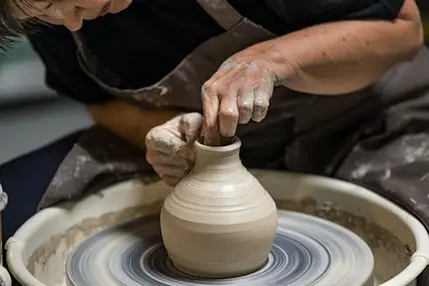Playing with clays while making pottery is not at all boring. But are you a beginner? Or are you having kids at your home who want to try their hands at pottery? Then trying out air dry clay can be the best choice. In case you have kids or are a beginner, you may not have proper knowledge about dealing with kilns; air-dry clay can be your savior.
But have you ever thought of putting air-dried clay on a pottery wheel? Some air-dry clays come with too much plasticity, making it difficult to throw them on the wheel. However, there are other air-dry clays too, which makes the job easier. So, let’s read on to know more.
In case you want to know a straightforward answer to this question, then the answer is yes, you can. However, some of the air-dry clays come with too much plasticity, making them challenging to use on a pottery wheel. However, other clays are made using cellulose fiber to the natural clays. Such air-dry clays can easily be used on the pottery wheel to create new and innovative shapes. However, the result is not going to be as effective as the regular ceramic clay.
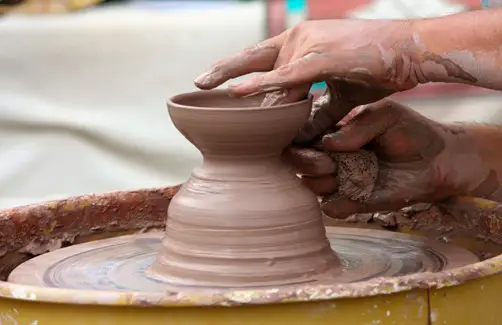
There is a large variety of air-dry clay, which comes with many differences in their character. Thus, whether you can use the clay on the potter’s wheel or not depends on the type of clay you are using.
What are the various types of air-dry clays?
In case you are thinking of using air-dry clay on the pottery wheel, you need to go through the complete knowledge about how many types of air-dry clay are available in the market. Whether you can use your pottery wheel for throwing the pottery clay or not depends upon the kind of clay you are picking. Let’s have a look at the variety of air-dry clay that you can get:
Polymer clay:
Polymer clay is a varied form of air-dry clay, which must be hardened while kept in the oven temperature. Polymer clay is usually made from a variety of bright primary colors. Also, it feels entirely plastic, like when it is hardened correctly in the oven.
Paper clay:
Paper clay is another kind of air-dry clay that is made out of a natural clay body. Unlike ceramic clay, it comes with the addition of fiber in it. The fiber is added to give it the proper amount of strength when the clay is dry. Thus, it doesn’t require to be fired.
It is called paper clay, as the fiber used in it is quite common to paper fiber. This clay is made with fiber, which is white and comes with a paper-like pulpy look. Hence it is very lightweight and not much stronger than regular ceramic clay. However, the addition of fiber can be done to any clay to give it the attribute of air-drying clay. A clay body can either be hardened at normal air temperature or can be fired.
Cold porcelain clay:
Cold porcelain is another kind of air-dry clay. The ingredients it includes are cornstarch and glue. Unlike the name, the clay does not contain porcelain. When the clay is hard, it gets a white and soft appearance, making it have such a name. There is no need to fire this clay since it is called air dry clay.
Which kind of air-dry clay should you use on a pottery wheel?
In case you want to use the air-dry clay on the potter’s wheel, you need to be brave enough to understand which clay is going well with the well. Though polymer and cold porcelain are quite common as clay, they come with too much plasticity. Such clays are widely used for making modeling sculptures.
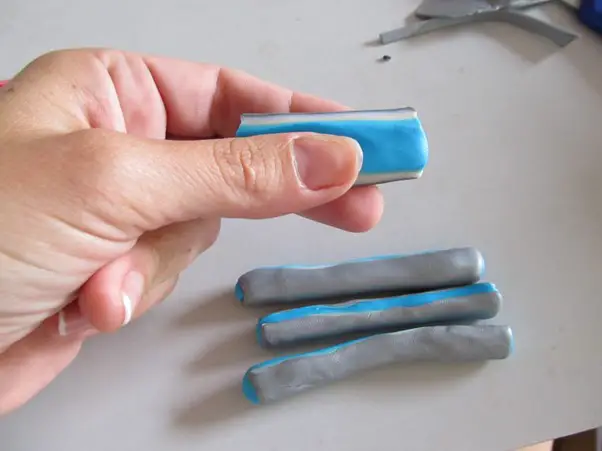
However, some of the paper clay packets claim that the clay can be used just like regular ceramic clay, which also includes the throwing of the clay on the wheel. The views about it are not so clear that this kind of clay can be used for the potter’s wheel. But it comes with enough fiber, which makes it steadier enough on the wheel.
While using clay on the wheel, you need to wedge it properly before you go for shaping. However, wedging may not feel the same as the consistency you get while wedging a ceramic wheel. However, centering can be more comfortable with paper clay. You may have difficult times while shaping as it may collapse on the first try. However, you can easily do it if you do not push the clay to bring out more than its actual limits. Ensure the wedging is good enough as it makes the clay easier to use and makes the consistency even.
Another best part about the air-dry clay is it is not too hard to wedge; instead, it’s pretty homogenous from the very beginning. It makes the clay highly cooperative on the wheel. Still, make sure that you are not using too much water on the clay while wedging, as it can collapse too fast. As you are done with shaping the clay, dry it properly. It may take longer than the ceramic clay to become evenly dry. Thus, you need to give it much time to become evenly dry from everywhere.
Have a quick look at which kind of clay is suitable for throwing on the pottery wheel and which type of clay is not.
| Types of clays | Whether you can use it or not |
| Polymer clay | No |
| Cold-porcelain clay | No |
| Paper clay | Yes |
You can use Crayola Air Dry Clay to get the best results on your pottery wheel.
What are the various benefits of using air-dry clay for your pottery?
Though it may be challenging to work with air dry clay on the pottery wheel, there are various other benefits. So, what are the benefits? Have a look:
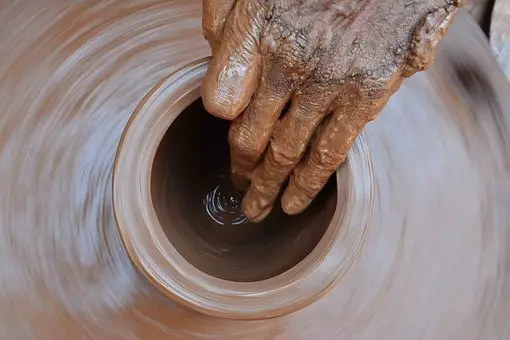
Beginner-friendly
Beginners and kids love air-dry clay due to its very smooth nature. The clay is much easier to work as there is no matter to fire the clay in the kiln. Also, it is easy to wedge and work with.
It feels like ceramic clay while throwing
You may not be working with ceramic clay. But choosing air-dry clay for your job will undoubtedly make you feel like using ceramic clay while throwing. However, post-throwing, it is not going to behave like regular ceramic clay.
Easy to shape
Working with air dry clay is widely prevalent among sculptors. The air-dry clay is relatively easy to shape. Due to its plasticity, you can easily add fine details to decorate the clay properly for making decorative pottery and sculptures.
Easy to decorate
As you are done with building pottery along with the air-dry clay, it becomes relatively easy to decorate it the way you want. You can paint it with any color or painting medium. In case the clay is white, you can leave it the way it is.
What are the disadvantages of air-dry clay?
You can easily skip the regular ceramic clay by using air-dry clay on the potter’s wheel. However, there are some disadvantages that you can face while working with air-dry clay. Have a look:
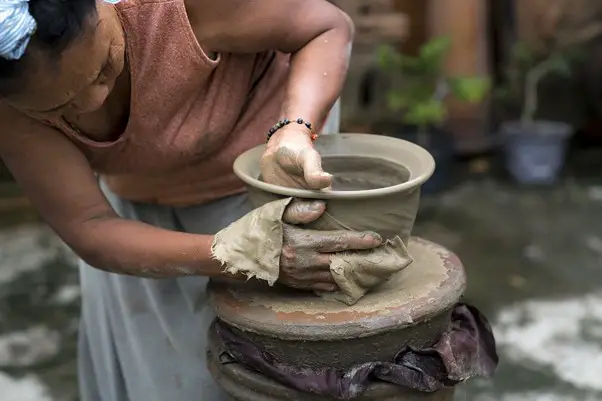
- It will not feel exactly like the air-dry clay you use while throwing it on the wheel. The techniques you apply while working with the ceramic clay may not become useful for the air-dry clay on the potter’s wheel.
- You cannot experiment with the glazing and firing while you are working with the air-dry clay.
- In case the clay is dry, the clay is very much porous if you do not apply any sealant over it. To use it as a waterproof pot, you need to give it a proper finishing coat or a seal.
- The air-dry pottery cannot be made food-safe or fully waterproof. As you cannot properly glaze air dry pots, it is better to use them for only decoration purposes.
What technique can you use for pottery making with air dry clay?
You can easily use pottery clay for the most traditional way of clay sculpting technique. The air-dry clay feels similar to the porcelain clay body when it is thrown on the pottery wheel. As an intermediate or an advanced pottery student, you can easily do it.
Here are the techniques you can use.
| Sculpting technique | How to do it? |
| Coil | To make a coil, you can take a small piece of clay. You need to squeeze it and give it the shape of a long sausage. Then you can roll it into a smooth and long piece to make a coil. |
| Slab | To make a slab, you need to roll your clay into a thin sheet of clay. A slab can easily be used for making the pottery base. |
| Pinch | Pinching is a modern pottery technique. You can easily make it using the pressing of your thumb on the ball of clay. The method involves repeatedly pinching the clay using your fingers and thumb. |
| Score and weld | Scoring means the scratching of the clay. To score and weld, you need to use slurry clay to join the pieces together in the various areas. |
Conclusion:
If you are thinking of using your air-dry clay for pottery making and throwing it on the potter’s wheel, then you can easily go for it. However, you need to pick the right kind of clay for your job. Make sure you choose air-dry clay that comes with enough fiber, making it easier to center while placing it on the pottery wheel. However, ensure that you are not using much water, or else it can collapse easily. Hopefully, this article is going to give you some helpful information.
Happy sculpting!

